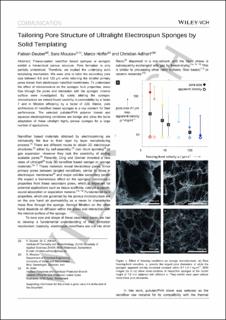Please use this identifier to cite or link to this item:
https://doi.org/10.21256/zhaw-1547Full metadata record
| DC Field | Value | Language |
|---|---|---|
| dc.contributor.author | Deuber, Fabian | - |
| dc.contributor.author | Mousavi, Sara | - |
| dc.contributor.author | Hofer, Marco | - |
| dc.contributor.author | Adlhart, Christian | - |
| dc.date.accessioned | 2018-01-16T15:35:52Z | - |
| dc.date.available | 2018-01-16T15:35:52Z | - |
| dc.date.issued | 2016-10-13 | - |
| dc.identifier.issn | 2365-6549 | de_CH |
| dc.identifier.uri | https://digitalcollection.zhaw.ch/handle/11475/2062 | - |
| dc.description.abstract | Freeze-casted nanofiber based sponges or aerogels exhibit a hierarchical porous structure. Pore formation is only partially understood. Therefore, we studied the underlying solid templating mechanism. We were able to tailor the secondary pore size between 9.5 and 123 µm while retaining the smaller primary pores known from electrospun nanofiber membranes. To understand the effect of microstructure on the sponges’ bulk properties, mass flow through the pores and interaction with the sponges’ internal surface were investigated. By solely altering the sponges’ microstructure we indeed found tunability in permeability by a factor 7 and in filtration efficiency by a factor of 220. Hence, pore architecture of nanofiber based sponges is a key element for their performance. The selected pullulan/PVA polymer blends and aqueous electrospinning conditions are benign and allow the facile adaptation of these ultralight highly porous sponges for a large number of applications. | de_CH |
| dc.language.iso | en | de_CH |
| dc.publisher | Wiley | de_CH |
| dc.relation.ispartof | ChemistrySelect | de_CH |
| dc.rights | http://creativecommons.org/licenses/by-nc-nd/4.0/ | de_CH |
| dc.subject | Electrospinning | de_CH |
| dc.subject | Aerogel | de_CH |
| dc.subject | Nanostructures | de_CH |
| dc.subject | Freeze-casting | de_CH |
| dc.subject.ddc | 660: Technische Chemie | de_CH |
| dc.title | Tailoring pore structure of ultralight electrospun sponges by solid templating | de_CH |
| dc.type | Beitrag in wissenschaftlicher Zeitschrift | de_CH |
| dcterms.type | Text | de_CH |
| zhaw.departement | Life Sciences und Facility Management | de_CH |
| zhaw.organisationalunit | Institut für Chemie und Biotechnologie (ICBT) | de_CH |
| zhaw.publisher.place | Hoboken | de_CH |
| dc.identifier.doi | 10.21256/zhaw-1547 | - |
| dc.identifier.doi | 10.1002/slct.201601084 | de_CH |
| zhaw.funding.eu | No | de_CH |
| zhaw.issue | 18 | de_CH |
| zhaw.originated.zhaw | Yes | de_CH |
| zhaw.pages.end | 5598 | de_CH |
| zhaw.pages.start | 5595 | de_CH |
| zhaw.publication.status | publishedVersion | de_CH |
| zhaw.volume | 1 | de_CH |
| zhaw.publication.review | Not specified | de_CH |
| Appears in collections: | Publikationen Life Sciences und Facility Management | |
Files in This Item:
| File | Description | Size | Format | |
|---|---|---|---|---|
| 2016_Adlhart_Tailoring_pore_structure_ChemistrySelect.pdf | 410.18 kB | Adobe PDF |  View/Open |
Show simple item record
Deuber, F., Mousavi, S., Hofer, M., & Adlhart, C. (2016). Tailoring pore structure of ultralight electrospun sponges by solid templating. ChemistrySelect, 1(18), 5595–5598. https://doi.org/10.21256/zhaw-1547
Deuber, F. et al. (2016) ‘Tailoring pore structure of ultralight electrospun sponges by solid templating’, ChemistrySelect, 1(18), pp. 5595–5598. Available at: https://doi.org/10.21256/zhaw-1547.
F. Deuber, S. Mousavi, M. Hofer, and C. Adlhart, “Tailoring pore structure of ultralight electrospun sponges by solid templating,” ChemistrySelect, vol. 1, no. 18, pp. 5595–5598, Oct. 2016, doi: 10.21256/zhaw-1547.
DEUBER, Fabian, Sara MOUSAVI, Marco HOFER und Christian ADLHART, 2016. Tailoring pore structure of ultralight electrospun sponges by solid templating. ChemistrySelect. 13 Oktober 2016. Bd. 1, Nr. 18, S. 5595–5598. DOI 10.21256/zhaw-1547
Deuber, Fabian, Sara Mousavi, Marco Hofer, and Christian Adlhart. 2016. “Tailoring Pore Structure of Ultralight Electrospun Sponges by Solid Templating.” ChemistrySelect 1 (18): 5595–98. https://doi.org/10.21256/zhaw-1547.
Deuber, Fabian, et al. “Tailoring Pore Structure of Ultralight Electrospun Sponges by Solid Templating.” ChemistrySelect, vol. 1, no. 18, Oct. 2016, pp. 5595–98, https://doi.org/10.21256/zhaw-1547.
Items in DSpace are protected by copyright, with all rights reserved, unless otherwise indicated.